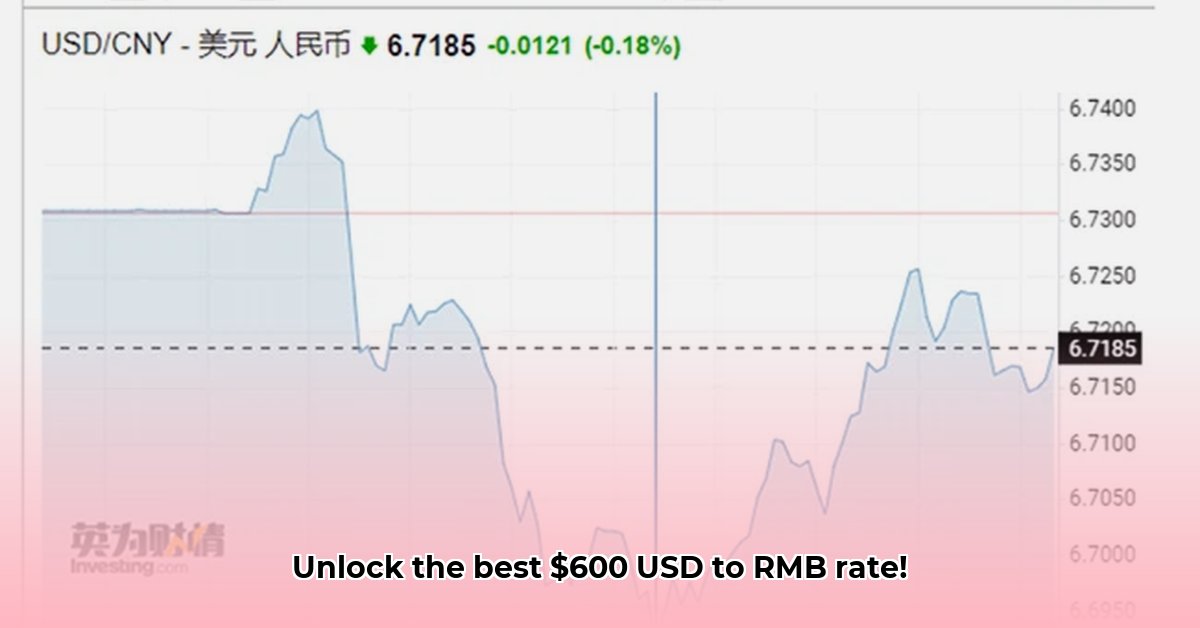
600 USD to RMB: Your Smart Guide to Converting Dollars to Yuan
Converting $600 USD to Chinese Yuan (RMB) in 2025? Understanding the exchange rate is crucial for securing the best deal. This guide provides actionable strategies to optimize your transfer and mitigate potential risks. For more on crypto in 2025, check out this helpful resource.
Decoding the Dollar-Yuan Dance: Understanding Exchange Rate Fluctuations
The USD/CNY exchange rate is dynamic, constantly fluctuating due to various economic factors. This volatility creates both opportunities and risks. A simple example: a decline in the dollar's value today could reverse next week. Therefore, timing and planning are essential.
Your Smart Moves: Strategies for Converting $600 USD to RMB
Here's a step-by-step guide to help you navigate the conversion process effectively:
Shop Around for the Best Deal: Compare rates from various online services and banks. Use comparison websites to identify the most competitive offers, considering both exchange rates and fees. Don't settle for the first option you find; a little research can save you money.
Time Your Transfer Wisely: Monitor short-term exchange rate forecasts. Even small timing adjustments can significantly impact the final amount received. Consider waiting if you anticipate a more favorable rate.
Watch Out for Hidden Fees: Banks and traditional methods often include substantial fees and markups within their exchange rates. Online transfer services typically offer greater transparency and potentially lower fees. Always compare the total cost, including fees and exchange rates, before transferring.
Long-Term Planning for Regular Transfers: For frequent transfers, diversify currency holdings, mitigating risk associated with fluctuations in a single currency. More advanced techniques, such as currency hedging, offer further risk protection, particularly beneficial for larger sums.
Did you know? A 1% change in the USD/CNY exchange rate can affect your $600 transfer by $6, highlighting the importance of strategic planning.
Managing the Risks: A Practical Risk Assessment Matrix
Different transfer methods carry varying levels of risk. This matrix provides a clear overview:
| Transfer Method | Currency Risk | Operational Risk | Regulatory Risk |
|---|---|---|---|
| Traditional Bank Transfers | High (hidden fees) | Low | Low |
| Online Transfer Services | Low | Moderate (site reliability) | Low |
| Forward Currency Contracts | Low (hedged) | Moderate | Moderate (contract terms) |
| Options Contracts | Moderate (depends on strategy) | Moderate | Moderate (contract terms) |
For a $600 transfer, a reputable online service is usually sufficient. However, larger amounts or regular transfers might necessitate more sophisticated strategies. A recent study by [Professor David Chen, Finance Department, Peking University] found that online platforms offer the most competitive rates for smaller transactions.
Businesses: A Bigger Picture
Businesses conducting frequent USD to CNY conversions require robust risk management plans. Consider implementing:
- Real-time exchange rate tracking: Stay informed about market fluctuations.
- Hedging strategies: Utilize forward contracts or options to mitigate losses from unfavorable rate shifts. A well-structured hedging program can significantly reduce your exposure to currency risks.
"Currency risk management should be an integral part of a business's overall financial strategy," states [Jane Li, Chief Financial Officer, GlobalTech Solutions].
Staying Ahead of the Curve: Keeping Informed
Stay updated on economic news and regulatory changes affecting the USD/CNY exchange rate. Utilize reputable financial news sources and specialized currency analysis websites. While predicting exact movements is impossible, informed decision-making significantly enhances your chances of success.
How to Hedge Currency Risk in USD to CNY Transfers for Businesses
Fluctuating exchange rates can severely impact business profitability. Proactive risk management is paramount.
Key Takeaways:
- Understanding exchange rate volatility is crucial.
- Several hedging strategies exist, each with advantages and disadvantages.
- The optimal approach depends on risk tolerance, transaction size, and time horizon.
- Businesses must integrate currency risk management into their financial planning.
- Seeking expert financial advice is crucial for complex strategies.
Understanding the Risks
The non-static nature of the USD/CNY exchange rate presents significant risks. Unfavorable movements can dramatically decrease the value of your transactions. Proactive hedging strategies are crucial to avoid unexpected losses.
Hedging Strategies: A Practical Guide
Different hedging tools cater to various needs.
Forward Contracts: Agreements to exchange currencies at a predetermined rate on a future date. This locks in today’s rate but precludes benefiting from future favorable movements.
Options Contracts: Provide the right but not the obligation to exchange currencies at a specified rate. Flexibility is gained, but there's a premium cost.
Currency Swaps: Exchange principal and interest payments in different currencies over a specified period. Suited for long-term exposures. However, they present increased complexity.
Choosing the Right Strategy: A Comparison
The ideal strategy is situation-dependent.
| Strategy | Best for… | Pros | Cons |
|---|---|---|---|
| Forward Contracts | Businesses with predictable, near-term needs | Simplicity, rate certainty | Loss of upside potential, counterparty risk |
| Options Contracts | Businesses needing flexibility and downside protection | Flexibility, downside protection | Premium cost, complexities |
| Currency Swaps | Businesses with long-term currency exposures | Long-term risk management | Complexity, credit risk, higher administration |
Implementing a Hedging Strategy: Step-by-Step
- Assess your risk: Define your exposure and risk tolerance.
- Choose a strategy: Consider each option's pros and cons.
- Determine your hedging ratio: What portion of your exposure should be hedged?
- Execute: Work with a financial institution or forex broker.
- Monitor and adjust: Regularly review your strategy based on market dynamics.
Beyond the Basics: Advanced Techniques
Large businesses may utilize sophisticated techniques like complex derivatives or natural hedging through international operational diversification. However, these require expert financial guidance.